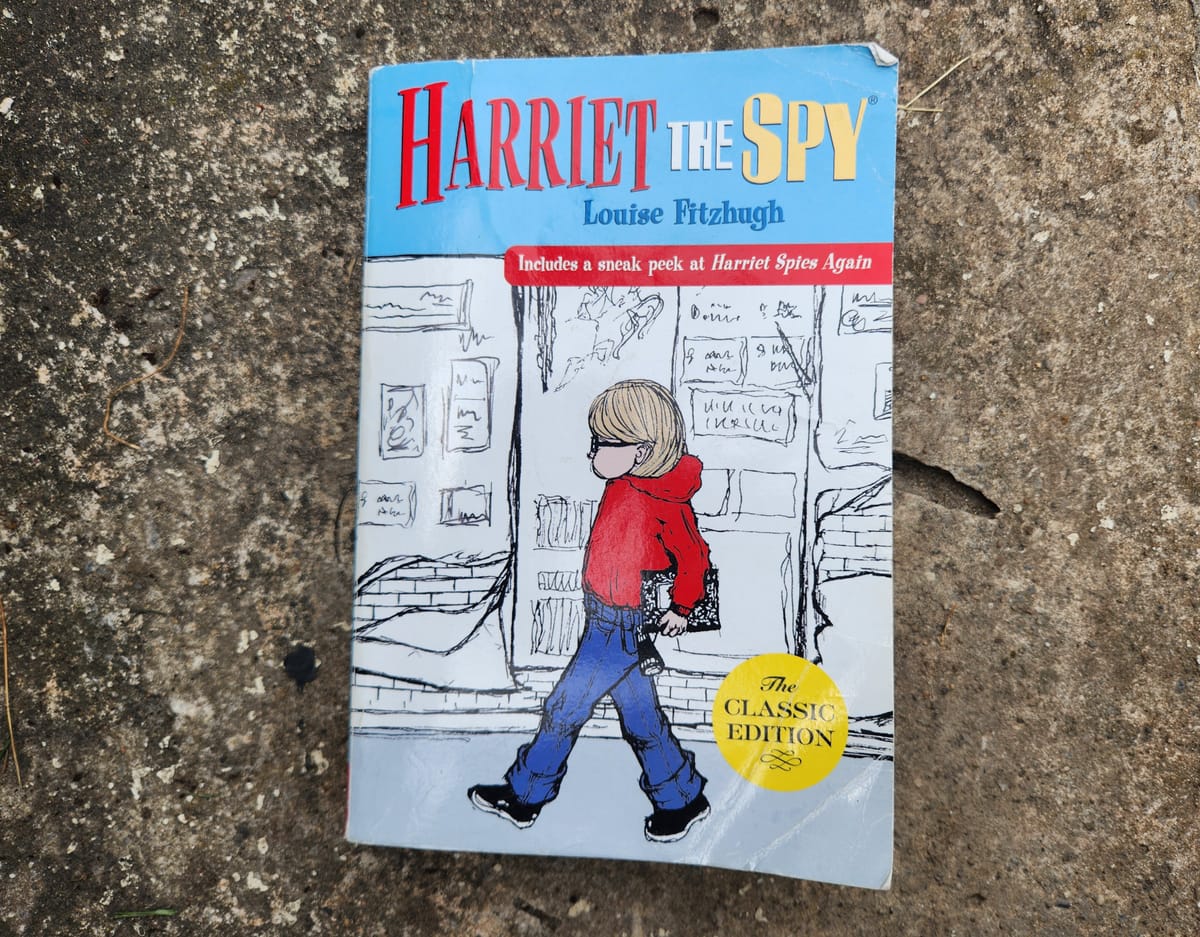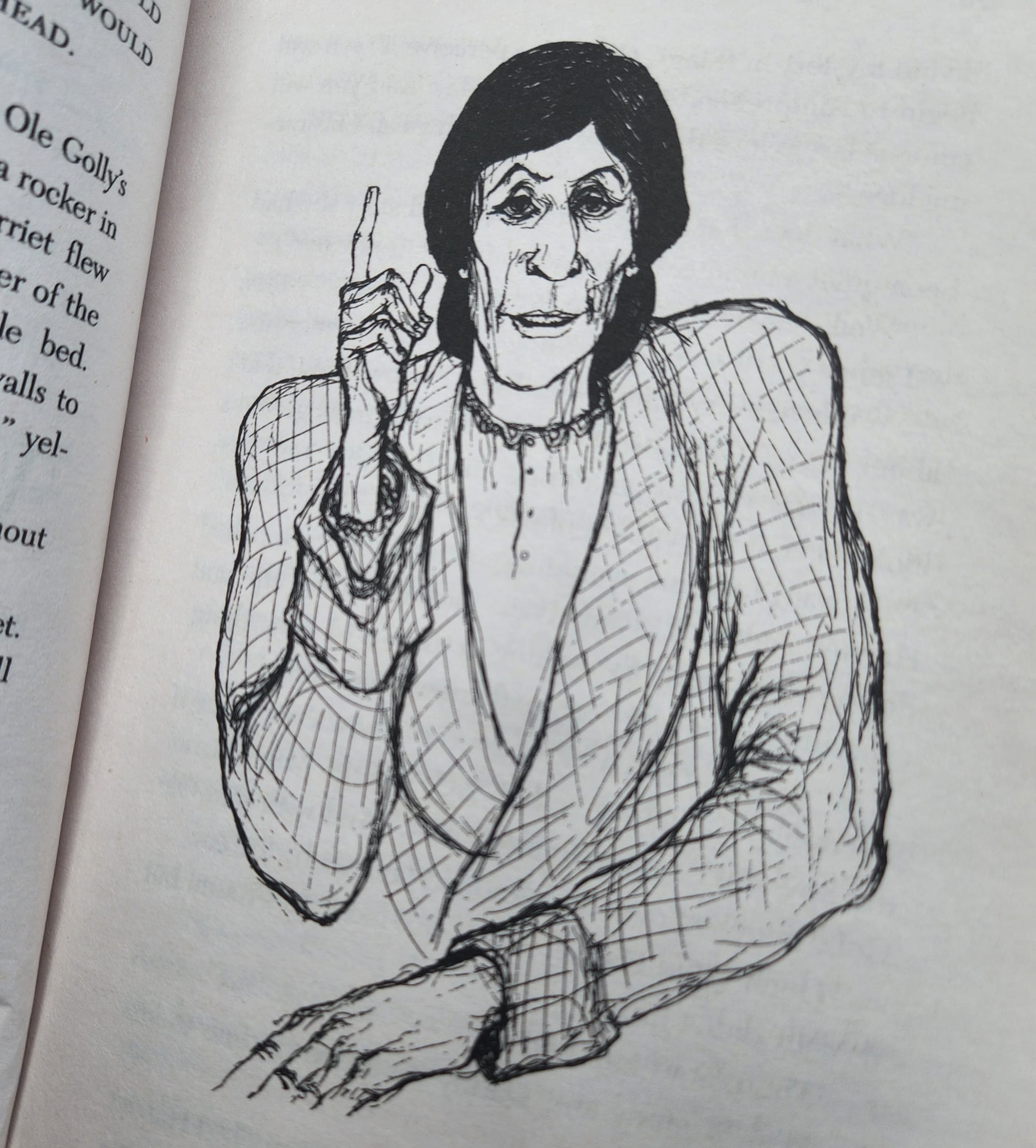Read Harriet the Spy as an adult

The best kid lit is enjoyed together, parent and child. But the very best can be enjoyed by an adult on their own. This month I’ll try to convince you to read Louise Fitzhugh’s Harriet the Spy, first published in 1964 and still fresh 60 years later, even if you don't have a child around.
I’ll also highlight my children’s lit hero, LeVar Burton, recommending one of my favourite episodes of his podcast LeVar Burton Reads. I’ll even sneak in a bonus book rec at the end.
Read Harriet the Spy as an adult
Lying in bed with my daughter and her Squishmallows, I was excited to crack open the baby blue, white, and fire engine red paperback I’d been telling her about: Harriet the Spy by Louise Fitzhugh. The 1996 movie, which is distinctly ‘90s in the way I remember the decade, full of primary colours and Rosie O’Donnell, was one of my favourites. My daughter, eight years old at the time, was the perfect age for the movie, but I wanted to read the book with her first. I hadn’t read it myself and was really excited. I was not prepared for how complex this book is and fell in love with Harriet the Spy as an adult. I think you should too.
The original trailer for Harriet the Spy (1996).
Harriet M. Welsch (the M. doesn’t stand for anything) is an aspiring spy in New York. Every day after school she embarks on her “route,” a tour of her New York City neighbourhood’s haunts and allies. Her notes from the tour, which are not confined to the people on her route and expand to include her family and friends, are detailed but judgemental and unkind. Her nanny, Ole Golly, tries to guide her morally and intellectually, but she cannot be there forever. The novel follows Harriet as her worldview expands from that of a child noting her first judgements to a slightly older child who learns to probe deeper than first impressions. A plot blurb like this suggests a simple coming-of-age story but the novel is so much more. People are weird, full of contradictions and unexpected delights, flaws and peculiarities. That complexity is what many adult readers love in their books, and here it is in classic children’s literature.
Let’s take Ole Golly as an example of a character with more complexity than is expected from a children’s book. Ole Golly, while lovingly portrayed by Rosie O’Donnell in the movie, is not so easy to understand or even love in the book.

Within the first 20 pages, she decides young Harriet and her friend Sport need to see beyond the Upper East Side, so she whisks them away to Far Rockaway, a working class neighbourhood in Queens on the coast of the Atlantic where the nanny’s mother lives. They take the subway, during which Harriet scribbles her observations of the fellow passengers:
MAN WITH ROLLED WHITE SOCKS, FAT LEGS. WOMAN WITH ONE CROSS-EYE AND A LONG NOSE. HORRIBLE LOOKING LITTLE BOY AND A FAT BLONDE MOTHER WHO KEEPS WIPING HIS NOSE OFF. FUNNY LADY LOOKS LIKE A TEACHER AND IS READING. I DON’T THINK I’D LIKE TO LIVE WHERE ANY OF THESE PEOPLE LIVE OR DO THE THINGS THEY DO. I BET THAT LITTLE BOY IS SAD AND CRIES A LOT. I BET THAT LADY WITH THE CROSS-EYE LOOKS IN THE MIRROR AND JUST FEELS TERRIBLE.
Harriet writes these things quickly. They are first impressions, scribbled but unkind. Us parents and the books we choose for our kids are supposed to teach the youth to be kind, so this adventure on the subway and eventually to Ole Golly’s family home should be an easy anecdote about not judging people. We expect a moral from Ole Golly about there being beauty in every corner, but we don’t get so simple a story. Instead Ole Golly brazenly insults her mother in front of the kids and her mother herself, as if she isn't there at all. “Behold Harriet,” she says, “a woman who never had any interest in anyone else, nor in any book, nor in any school, nor in any way of life, but has lived her whole life in this room, eating and sleeping and waiting to die.” And then Ole Golly, Harriet, and Sport leave! That’s it! Ole Golly, the adult in the room, isn’t a perfect guide. She has frustrations and flaws of her own. How very unlike the squawking parents of Charlie Brown she is!

Over the course of the book, Harriet writes more unkind judgements, and eventually has to deal with the consequences. Parents talk to their kids about consequences all the time, but rarely do we see the consequences enforced for so long. A massive portion of the book is Harriet dealing with the “Spy Catchers Club,” a group of her peers that includes her former friends who ostracise and harass her. Her punishment is brutal and will likely stay with her into adulthood. Judging people, thinking you are above them, and realising you are not is a hard lesson to learn–one that Harriet eventually absorbs, and one that would be good for me and other adults to re-absorb too.
But this is also a story about how nothing is simple, not even the lessons we learn. Harriet, through the guidance of Ole Golly, however imperfect it may be, sees how big the world is, how full it is of details that tell you one thing or another about life. Her subjectivity will never leave her. She will always be processing observations through her perspective, and never fully see the complete picture. The world is giant and complex and weird and we’ll never fully know it, but we must continue to engage and explore. What a wonderful way to approach the world!
In a lot of children’s literature there are multiple levels on which to read: that which is for the child and the bigger picture for the adult. But in Harriet the Spy, there is a big messy story that a child and an adult can experience together, through their own perspectives and in conversation. There aren’t double entendres that will make an adult laugh while a child doesn’t understand, but a world that can be explored and discussed. So read Harriet the Spy as an adult. Better yet, read it as an adult with a child and her Squishmallows, and get into the nitty gritty of humanity.
Goodbye Levar Burton Reads
One of my favourite podcasts is LeVar Burton Reads, and it recently aired its final episode. Being a child of the ‘90s and a massive Star Trek fan, LeVar Burton was a big part of my childhood, and he continues to enrich my ears with his friendly voice while I walk my dogs or feed my babies. Sadly, after running from 2017-2024, LeVar Burton Reads has come to an end. To celebrate this close, I’m sharing one of my favourite recent episodes. Burton reads Percival Everett’s “The Appropriation of Cultures” with an audible wink and smile. Having just finished Everett’s James, I was ripe for more of Everett’s cheeky wit. I love the way he hits a theme so hard it’s unmistakable. Everett frequently tackles racism in his work, and the way he lays out his themes has an urgency to it necessary for the work of dismantling systemic racism. So celebrate LeVar Burton, listen to him read Percival Everett, and then head out and to your local library for your copy of James.
Bonus points for watching LeVar Burton accept a lifetime achievement award from Laurence Fishburne. I wept through his speech.
Prediction: James will be on the New York Times "10 Best Books of 2024" list.